When is a Pot Belly Stomach Not a Pot Belly Stomach?
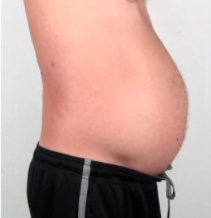 What is the cause of a pot belly?
What is the cause of a pot belly?
Someone who has a pot belly has a round stomach that sticks out. Often because they eat or drink too much, but not always.
A pot belly stomach is usually caused by an excess of fat or having weak belly muscles.
Fat is found between your skin and muscles.
People carry fat on their bodies in different ways. If you tend to gain weight in your belly, once the layer of fat in your abdomen becomes more than an inch thick, you`ll have the appearance of a potbelly stomach.
Ordinarily, the main way to get rid of it is to lose weight. But as you will see this isn’t the case for everyone.
For whatever reason, some people are genetically destined to have extra fat in their bellies. These folks store fat primarily around their intestines.
It isn’t easy to get rid of belly fat. It`s the last place from which they`ll lose body fat.
Like I said at the start pot bellies also may be caused by weak belly muscles and, rarely, tumors.
If you don’t think you have tumors and don’t think you are overweight, you possibly have weak belly muscles.
If that is your issue it isn’t hard to correct with the right exercise routine.
But what if you are skinny with a pot belly stomach? And don’t have weak abdominal muscles.
There are certain people who have big bellies for a different reason than most.
If you want to know if you are one of these people just touch your stomach.
Is it hard or soft?
That will tell you a lot.
I always carry an extra ten or fifteen pounds around my waist and belly. If I touch my stomach it jiggles.
If you have a fat stomach it should be soft like mine.
If you touch your big belly and it is hard, something else is going on.
What is a psoas?
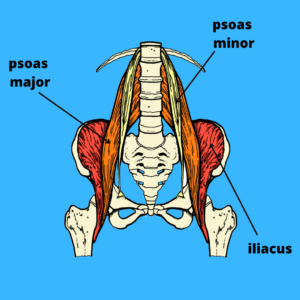 Deep in the bowl of the pelvis lies the body’s most important muscle, and it is the most mysterious as well.
Deep in the bowl of the pelvis lies the body’s most important muscle, and it is the most mysterious as well.
This is a muscle that most people have never heard of and can’t pronounce.
And even though doctors learn about this muscle in school it is not mentioned nearly enough.
Especially when it comes to pain and trauma.
And in this case, when it comes to being skinny with pot belly.
The psoas is the body’s most important muscle for three reasons.
- It is the muscle of standing.
- It is the muscle of walking.
- It is the muscle of pain and trauma.
#3 is where the potbelly stomach comes in.
But first, number one, the psoas is the muscle of standing.
This is because it is one of only three muscles that connect the legs to the spine.
The two other muscles– piriformis & gluteus maximus– connect the legs to the spine at the back of the body.
The psoas connects the legs to the spine in the front.
Together these three muscles are doing a lot of the work to keep the spine erect on top of the pelvis.
Number two, the psoas is the main muscle of walking.
There are many muscles in the body are involved in walking– it is truly a whole-body experience.
But when we are walking correctly, each step we take is initiated by the psoas, the body’s main hip flexor.
One way to look at it is as if with each step the body is about to fall forward. But instead of falling on our face, the brain tells the psoas of the back leg to come forward.
And then it happens again. And again. And again.
But the psoas gets interesting when we see it as, number three, the muscle of pain and trauma.
Why do I have a pot belly?
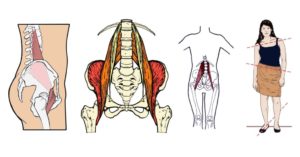 You might be lacking body fat but can still have the appearance of a pot belly.
You might be lacking body fat but can still have the appearance of a pot belly.
This might be due to a tight psoas muscle that is messing with the contents of your abdomen.
Let’s go back to the psoas as the muscle of pain and trauma.
The psoas connects the legs to the spine attaching at the base of the ribcage and along the lumbar spine.
From there it moves down across the pelvis and backward to attach to the back half of the inner thigh.
When I say that it is the muscle of pain and trauma things get a little woo-woo.
But I can’t help it.
It is some crazy stuff.
The body is designed to process stimuli through two main systems.
The sympathetic nervous system, which is the system of excitation, is related to our fight or flight response.
The parasympathetic nervous system is about relaxation and these two systems work together to seek balance for our body and mind.
This balance is called homeostasis.
But the truth is, life is difficult and we often can’t process all the energy thrown at us successfully.
An example of this is someone who lives in a war zone. Their sympathetic nervous system will be on high alert, always waiting for the next danger.
When the body spends too much time in the sympathetic nervous system it has to do something with all of the energy that is not being balanced out by the sympathetic nervous system.
That unprocessed energy that can’t be handled at that moment, gets stored in the psoas.
That’s the woo-woo part. There are plenty of people more than willing to tell you that muscles don’t hold energy and trauma but I beg to differ.
And if you are skinny with a potbelly and can’t understand why this might be the reason.
Why am I skinny with a pot belly stomach?
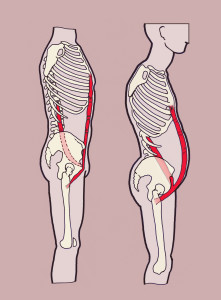 Inside the lower portion of the trunk, we have the abdominal cavity.
Inside the lower portion of the trunk, we have the abdominal cavity.
The abdominal cavity contains most of the digestive tract, the liver and pancreas, the spleen, and the kidneys.
Let’s visualize what makes up a happy and healthy abdominal cavity. We can see it as a box:
- The psoas major is the back wall.
- The rectus abdominis, and the other abdominal muscles, are the front wall
- The diaphragm muscle is the top.
- The pelvic floor muscles are the bottom.
We are trying to create harmony in the abdominal cavity through good posture, movement patterns, and exercise.
If we can do that everything inside the cavity will have a happy home with room to work effectively.
Now imagine that the psoas on one or both sides is tight or troubled.
A tight iliopsoas affects the body in varying degrees depending on how tight it is.
Classically, the tight psoas pulls the affected leg up and the affected shoulder down, shortening or crunching, that side of the body.
It also pulls the lumbar vertebrae forward.
Internally, it is very subtle. The shortening of the muscle and the forward curve of the lumbar spine changes the space in the abdominal cavity.
As a result, it moves everything in front of it forward. The intestines, liver, etc, are pushed into the abdominal muscles.
If you aren’t a skinny pot belly person this is likely still happening to you. You just don’t notice it.
But if you are skinny there is no way to hide what is going on inside.
And just to add one more wrinkle.
A tight psoas and six-pack abs do a whole different number on our intestines and the rest.
I’m not a fan of hard muscle which means I am not a fan of six-pack abs.
A tight psoas and six-pack abs kind of shrink wrap everything in the abdominal cavity and that is as bad as it sounds.
How to get rid of a pot belly stomach
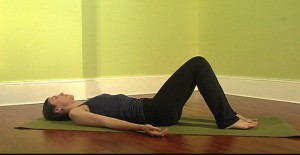 Now let me tell you how to get rid of a potbelly stomach if you are skinny and/or your belly is hard.
Now let me tell you how to get rid of a potbelly stomach if you are skinny and/or your belly is hard.
Meet your new best friend: Constructive Rest.
Constructive rest is a pose invented by Lulu Sweigard whose work has had a big influence on me.
She created it as an exercise for dancers. But over the years it has been adapted as a tonic for the nervous system.
And what a tonic is.
I have students and clients that have been doing Constructive Rest for years and years on a daily basis.
And if they don’t do it every day, they know it is there for them when they need it.
It is so simple and yet so very powerful.
And if you have a pot belly stomach that you want to get rid of this might well be your answer.
It’s possible that you’ll do this exercise and not feel anything; it will still be good for you.
Relaxation doesn’t always feel like something but the more you do it the better your body and mind will be.
- Lie on your back with your knees bent and your feet flat on the floor. Your heels are 12 to 16 inches away from your pelvis, in line with your sit bones.
- Tie a belt around the middle of the thighs. You want to be able to relax, and not have to think too much about the position of your legs.
- Then do nothing. Discomfort arises from conditioned muscular patterns. Try not to shift or move when unpleasant sensations arise.
- You are hoping to feel sensations that you can sit with, and if possible, allow to pass.
- But you are not here to suffer. If sensations come up and you feel that you have to move, feel free to move. Then come back to where you were and start again.
Constructive Rest is a deep and relaxing psoas release that you can use for years to come.
Even after you get rid of your pot belly stomach.
